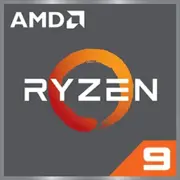AMD Ryzen 9 6980HX

AMD Ryzen 9 6980HX: Power and Efficiency in an Ultraportable Format
March 2025
Modern laptops require a balance between performance and battery life, and AMD's Ryzen 9 series processors remain a key tool for achieving this goal. The Ryzen 9 6980HX, introduced in 2022, continues to be relevant in 2025, thanks to its advanced architecture and optimization. Let’s explore why this chip is still in demand and who it is suitable for.
Architecture and Process Technology: Rembrandt on 6 nm
Cores, Threads, and Frequencies
The Ryzen 9 6980HX is built on the Zen 3+ architecture (codename — Rembrandt) and manufactured using TSMC's 6-nm FinFET technology. This represents an evolution of the 7-nm technology, providing an 18% greater transistor density and improved energy efficiency.
- 8 cores / 16 threads with a base frequency of 3.3 GHz and a maximum turbo frequency of 5.0 GHz.
- 16 MB of L3 cache—double that of the Ryzen 5 series, speeding up data processing in multithreaded tasks.
- Support for DDR5-4800 and PCIe 4.0 (20 lanes) for fast memory and storage.
Integrated Graphics: Radeon 680M
The standout feature of this chip is the integrated GPU, Radeon 680M, based on the RDNA 2 architecture:
- 12 compute units (768 stream processors);
- Frequency of up to 2.4 GHz;
- Support for Ray Tracing and FSR 2.0 to enhance graphics in games.
This is the most powerful integrated GPU among mobile processors from 2022 to 2024. In light workloads, it often replaces discrete GPUs like the NVIDIA MX550. For instance, in CS:GO on medium settings (1080p), it delivers stable 60–80 FPS, and in Cyberpunk 2077 with FSR—it achieves 30–40 FPS on low settings.
TDP 45W: Power Management
The nominal thermal design power (TDP) is 45 W, but in turbo mode, consumption can reach 65–80 W, depending on the laptop's cooling system.
Features:
- Precision Boost 2—automatic core overclocking when thermal headroom is available.
- Adaptive Power Management—dynamic power allocation between the CPU and GPU.
- Idle power saving: Under minimal load, the chip reduces its frequency to 1.2 GHz, consuming only 3–5 W.
Efficient cooling is required for stable operation; laptops with dual fans and heat pipes are recommended (for example, the ASUS ROG Zephyrus G14).
Performance: Benchmarks and Real-World Tasks
Office and Multimedia
- PCMark 10: 6800 points—quick responsiveness in browsers, Excel, Word.
- Video rendering (Premiere Pro): Renders a 4K clip in 8 minutes (compared to 10 for the Core i7-12700H).
- Photo editing: No delays in Photoshop with 50 layers stacked.
Gaming
- With discrete GPU (RTX 4070): In Cyberpunk 2077 (1440p, Ultra)—75–90 FPS.
- On iGPU: Elden Ring (720p, Low)—35–45 FPS; Fortnite (1080p, Medium + FSR)—50–60 FPS.
Turbo Mode: Pros and Cons
When Turbo mode is activated (for example, via Ryzen Controller), CPU frequency can reach 5.0 GHz; however, this is short-lived: throttling begins after 10–15 minutes due to overheating. In compact laptops (thickness < 20 mm), it is better to limit TDP to 35 W for balance.
Use Cases: Who Needs the 6980HX?
1. Professionals: Video editors, programmers, CAD engineers. 16 threads accelerate code compilation and 3D modeling.
2. Gamers: In tandem with a discrete GPU (RTX 4060/4070), the chip unlocks AAA titles.
3. General Users: Those who appreciate extra power for multitasking (streaming + work + gaming).
Battery Life: Up to 10 Hours in Power-Saving Mode
With a battery capacity of 80–90 Wh (for example, the Lenovo Legion Slim 7):
- Video playback: Up to 10 hours (brightness 150 nits, Wi-Fi on).
- Office tasks: 7–8 hours.
- Gaming on iGPU: 1.5–2 hours.
Power-saving technologies:
- AMD PowerNow!—adaptive core switching.
- SmartShift—redistribution of power between CPU and GPU.
Comparison with Competitors
AMD Ryzen 9 7900HS (2023)
- Zen 4, 5 nm, up to 5.2 GHz. 15% faster in single-threaded tasks but more expensive ($1600+).
Intel Core i9-13900H (2023)
- 14 cores (6P+8E), up to 5.4 GHz. Better in single-threaded load (by 8–10%), but the Iris Xe iGPU is twice as weak as the Radeon 680M.
Apple M2 Pro (2024)
- More power-efficient (18–20 hours of use), but gaming and Windows software options are limited. Price starts at $2000.
Pros and Cons of the Ryzen 9 6980HX
Strengths:
- Best-in-class integrated GPU.
- High multithreaded performance.
- Support for DDR5 and PCIe 4.0.
Weaknesses:
- Heating in thin chassis.
- Price of laptops starts at $1400 (for example, the ASUS ROG Flow X13).
Recommendations for Laptop Choice
1. Gaming Laptop: Look for models with RTX 4070 and a 144 Hz display (price: $1800–$2200). Example: MSI Delta 15.
2. Ultrabook: Consider the ASUS ZenBook Pro 14 with an OLED display and weight of 1.6 kg ($1600–$1900).
3. Workstation: Dell XPS 15 with 64 GB DDR5 and vapor chamber cooling ($2000+).
What to Check:
- Cooling system (preferably 3 heat pipes).
- Ports (at least 2 USB-C with PD).
- Battery of at least 80 Wh.
Final Verdict
The Ryzen 9 6980HX in 2025 is the choice for those who need versatility without compromise. It suits:
- Students for studying and gaming;
- Creatives working in Adobe applications;
- Travelers who value battery life.
Key advantages: powerful iGPU, support for the latest memory technologies, and reasonable pricing in the secondary market (laptops starting from $1000). If you're willing to pay for newer models, consider the Ryzen 9 7900HS, but for most tasks, the 6980HX will remain relevant for another 2–3 years.
Basic
CPU Specifications
Memory Specifications
GPU Specifications
Miscellaneous
Related CPU Comparisons
Share in social media
Or Link To Us
<a href="https://cputronic.com/en/cpu/amd-ryzen-9-6980hx" target="_blank">AMD Ryzen 9 6980HX</a>
